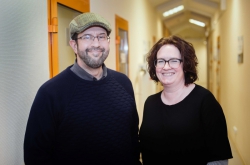What are basics of co-creation and how to use this?
In the broad sense, co-creation is when people create something new together. So, what are the basics of the co-creation course, which will take place at ITMO? First of all, its main idea is that everybody has creative potential. It is necessary to develop it and understand how to use all its opportunities.
You know that we can work miracles when time is up, when deadlines are pressing. There are many idioms that explain that! Anyway, the main drivers for activating one’s creativity are unforeseen circumstances, stress, and danger — they make us ingenious. One has to be able to switch on his or her creativeness not only by such pressure. For this purpose it is necessary to show a positive result of one’s creativeness, so that he will understand that he can create something good at any moment.
I’d also like to add that a potential of a group is stronger than the individual one. Usually, during teamwork, talented people start with rivalry. It never gives results. It means that before you learn how to be creative at any time, you have to be able to create in cooperation with others.
The next idea is that there are two types of skills: intellectual and creative. It may seem that creative skills are easy. However, it is about working harder on oneself. One of the great examples is Jack London who wrote something every single day, spent over 15 hours for writing per day and published 40 books. It is possible to learn to create on schedule. Apart from making efforts, one has to understand psychological and physiological processes in one’s brain.
Just imagine that you still use a computer that you bought in the 90-ss. You install Windows 97, 98, 2000, 2007 one by one without deleting previous versions, and they work simultaneously. It is obvious that its running will be brought down. The brain works in a similar way.

Photo credit: depositphotos.com
How to arrange this chaos and force oneself to create not only when deadlines press, but according to the plan?
The first and main life-hack is that you have to answer the question: why do I need creative activity? What personal issue or career task I have to solve this week using creativity? If I can answer this question, I have the time and energy to create. Ask yourself: "How to make repairs in my flat at a certain price?", or "How to find an apartment by the evening?", or "How to pass all exams in just two days?". If you cannot answer, your creative abilities will not start working.
Speaking of a teamwork — it is very hard to create in cooperation with partners. It is difficult because you constantly have to discuss, argue and try coming to an agreement. However, it can result in increasing of productivity. It is better to prepare for exams or make repairs together. It is also much easier when you can discuss a problem with somebody.
The first step towards controlled creativity is to understand that there are two worlds — real and ideal. Many people deny the second one. When you are walking during night time and notice something strange in the bushes, you run away as quick as it possible. But in fact, there was only darkness, and bushes, and something you were afraid of was unreal. It is quite the same with knowledge, competencies and skills — until something happens, you cannot apply them, as they are unreal.

Managing Creativity course
What if I tell myself: "Yes, I am ready to solve a problem using my creativeness!", but can’t move any further. How do I move from words to action?
You need to improve yourself according to a certain plan. Actually, we are going to have eight lectures for ITMO students. Every time we will pay attention to activities that help participants find out their creative potential. All the tasks will be in test format. Furthermore, each participant will receive a feedback from his team — his teammates will estimate his strong and weak points.
At the beginning of the course I will give participants so-called creative passports — they will write down the information during all lectures. By using them, students will fix the things they don’t usually pay attention to in real life, and also those skills that require many years to obtain. Those who are really interested in self-development will make a breakthrough — not everyone, only those who really want to do that.
Will the participants solve real tasks?
They will learn heuristic mechanisms and techniques like brainstorming, empathy and others. The students will start with applying them to training tasks. And then, they will move to solving real business tasks — this is one of peculiarities of our course. Here is one of the examples: these days, fewer and fewer people read automated letters and sign out, as there are tons of newsletters and nobody can cope with it. So the challenge is how to write a letter that people would read? It is all about creativity.

Managing Creativity course
What is the future of the co-creation concept? As you know, it is now common for companies to look for candidates with not only competencies, but teamwork skills as well.
Last spring, Global Education Futures, an international collaborative platform, made a statement that went unnoticed by the wide audience: "We think that in several decades, co-creation will become the most popular concept, as it makes people create socially important values."
The specialists of this platform predict that in five-seven years, companies will not hire individualists, because it takes time to teach him to work in collaboration with a team, and then it will be necessary to wait for years until he starts creating on a regular basis.
As far as I may judge, it will be more beneficial for companies to hire tight creative teams. I mean not only the event-industry or ad agencies. Such teams will be able to solve various tasks that at first sight don’t seem creative. For instance, how to optimize industrial processes, arrange machine units properly, change technological lines and so forth. These are challenging tasks.
That is why now, there is the following hypothesis: creative teams will be in more and more demand, as it will get expensive to gather a team inside a company. Where to find such teams?
It becomes clear that only those companies that provide analyses will be successful in the constantly changing world. It means that science becomes widespread like education became evaluable in previous times. Science is a new tool for business development. Companies have to constantly search for new solutions — it is impossible without a creative team.




